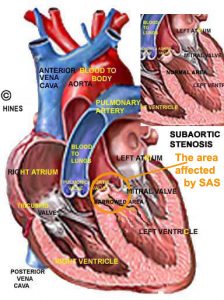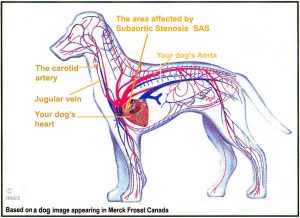Subaortic Stenosis – When The Left Side Exit From Your Puppy’s Heart Is Too Narrow
aka SAS, Subaortic Valvular Stenosis, Aortic Stenosis, AS
Ron Hines DVM PhD
Subaortic Stenosis (SAS) is an abnormal restriction of the flow of blood as it leaves your dog’s heart to enter its aorta and then flow to all parts of its body – something akin (similar) to your garden hose having a kink near the faucet. An SAS obstruction is caused by an abnormal ring of fibrous tissue (stenotic ring). (read here & here) And like a kinked hose, it makes a distinctive sound – one that your veterinarian will pick up through his/her stethoscope. You can listen to that sound through the two links above. SAS is a heartbreaking discovery for every owner of a new puppy. And it is usually a veterinarian like me who has the sad job of delivering the news.
When any form of aortic stenosis (SAS or AS) exists in your pet, your dog’s blood must pass through a channel that is too narrow for an unrestricted, unhindered flow of blood.
Reports that focus solely on SAS tend to place the frequency of the disease considerably higher than those that review the frequency of all developmental heart issues in dogs. The (probably more objective) canine heart disease surveys place subaortic stenosis as a component of about 20% of the young dogs presented to them with heart issues. But studies that focus only on SAS consider SAS and AS to be the second most common inherited heart diseases of dogs. Some large-dog breeders even believe that SAS might be the most frequent inherited heart defect.
Veterinarians see cases of SAS most frequently in golden retrievers and boxers. But the problem occasionally plagues rottweilers, Newfoundlands, other larger breeds and a few smaller breeds as well. That is particularly true when the dog’s parents were too closely related. Restrictions in the flow of blood (stenosis) makes your dog’s heart work harder than it should. Eventually, that can lead to heart failure.
Many things can go wrong when a young heart is developing in the womb. Some dogs with SAS are born with more than one heart blood flow defect.
Subaortic stenosis or SAS is a complex genetic problem. How it is inherited has yet to be worked out and there may well be several avenues that can lead to it. We assume that puppies that suffer from SAS have inherited a gene-combination from one or both of their parents that caused their heart to develop abnormally. In the case of Newfoundland dogs, the presence of a defective single member of a two-gene pair (alleles) appears to favor the development of SAS; while the presence of two defective genes in the allele pair is lethal to the puppy embryo. (read here) Others came to the conclusion that a number of defective gene pairs were required before SAS would occur in Newfoundlands (a polygenic trait). (read here)
In Dogue de Bordeauxs a single non-defective gene of a two-gene pair was thought to be enough to prevent SAS. (read here) So it is likely that there are multiple potential genetic ways for SAS to develop. Some of those gene combinations that appear to favor SAS also favor abnormal narrowing of the blood channels leading from the dog’s heart to its lungs (pulmonary artery stenosis). (read here)
Veterinarians cannot accurately predict which matings might produce puppies with this condition and which will not – other than that the more closely related your dog’s parents were to each other, the more likely genetic diseases such as SAS are to occur. The Orthopedic Foundation For Animals (OFA), an organization founded to discover the genetic basis of canine hip dysplasia in an attempt to eradicate it, established a registry for “cardiac disease-free” dogs that includes screening for SAS. I do not know if that approach will reduced the incidence of SAS. Until veterinarians better understand how the disease is inherited it will be difficult to make progress in eliminating SAS. When I last checked, North Carolina State Veterinary School had a project attempting to discover ways to predict the likelihood of SAS occurring in Newfoundland dogs. They solicited DNA samples (and a fee).
There are some who have associate SAS in dogs with heart infections (bacterial endocarditis). That is probably because in people, restricted blood flow to the aorta sometimes occurs subsequent to strep throat infections which have damaged the heart’s aortic valve. (read here) But I know of no cases where such an infection was ever confirmed to have been the cause of SAS in a dog.
When And How Is A Case OF SAS Usually Discovered?
The most common scenario regarding dog owners and SAS is a heart murmur picked up by your veterinarian when your puppy received its puppy shot series. If the pet’s heart sounds were not examined during those vaccinations, it is usually the unexpected death or near death of the puppy that makes this disease a suspect. This is where I go into to make my usual pitch that you visit your local veterinarian for those critical puppy and kitten shots (read here), not some traveling low-cost vaccination bus. The actual cost of lining up for those shoddy services can actually be heartbreaking.
But not all puppies with the SAS condition have heart murmurs when they are first examined. Some don’t develop an audible heart murmur before they received their last puppy vaccinations. In their early stages, sometimes these murmurs come and go. And sometimes these juvenile heart murmurs are not signs of SAS or any other heart problem at all. Heart murmurs that have no apparent cause are called innocent heart murmurs. They can leave as mysteriously as they appeared. Significant anemia also causes heart murmurs. Anemia can be due to anything from heavy flea or hookworm infestation, to nutritional deprivation. (read here) Nevertheless, in cases of SAS, the loudness of a heart murmur is often an indication of the severity of the dog’s blood flow problem. (read here)
Heat murmurs due to SAS are often the loudest over the dog’s left lower chest during the first heart sound (systole). Others report finding SAS murmurs also present higher up on the right side of the pet’s chest. I suppose it depends on the dog’s chest conformation as well as other co-existing heart defects that may be present.
When SAS is discovered later in life, the dog was usually brought to the vet because of general fatigue and/or fainting. By that point most of the symptoms are those of heart failure.
What Are The Signs Of SAS That I Might See In My Puppy or Dog?
The progression and severity of SAS vary greatly between dogs. So, the symptoms the disease causes (if any) vary greatly as well. Some dogs with mild SAS never become incapacitated or visibly ill. The blood “outlet channel” from your dog’s left ventricle consists of the area on each side of the aortic heart valve as well as the valve itself (subvalvular→valve→supravalvular). The amount of tissue distortion in those three areas (they are also called the left ventricular outflow tract or LVOT) vary dog-by-dog.
As I mentioned, most often, you will see no signs of ill health at all when your dog is a puppy. That is because SAS is a problem of the growing heart. And most of that growth occurs in a puppy after birth. But as time goes by, your puppy’s heart muscle walls might thicken (hypertrophy) due to the back pressures they must pump against. With that thickening come problems in the heart’s electrical system that can cause fainting (syncope), weakness, lethargy and even unexpected sudden death. The fainting is thought to be due to electrical disturbances in the heart’s nerve network (caused by scaring). A healthy cardiac nerve system is necessary to keep the organ beating properly (i.e. prevent ventricular arrhythmias). Although it has not been worked out in dogs, it is assumed to be similar to what occurs in humans with aortic valve stenosis. Thankfully, I do not believe that SAS is a painful condition.
If your dog survives those electrical heart disturbances the situation can still progress to congestive heart failure (CHF). When it does, the symptoms include a weak pulse, respiratory difficulties, coughing and perhaps rear leg weakness. Irregular left ventricular heartbeats cause forward and a backward blood flow pathology. They provide inadequate forward oxygen to the body; while the blood “waiting in line” to pass through the SAS restriction pools and backs up into the dog’s lungs. (read here)
What Diagnostic Tests Might My Veterinarians Perform?
To decide how serious your pet’s heart murmur really is, an echocardiogram (doppler ultrasound) needs to be performed by a veterinary cardiologist. Although not as important as it once was, veterinary cardiologists are also better trained than I am in evaluating the distinct but subtle sound variations a heart murmur makes. To an experienced ear, the loudness, interval and tone of a heart murmur can be an indication of the severity of a heart abnormality. And the point on the chest where the murmur is the loudest can give cardiologists clues as to what portion of your dog’s heart might be responsible for it. Doppler ultrasound has advanced human and veterinary cardiology by light years. Read more about Cardiac Doppler Ultrasound farther along in this article.
X-rays
Ordinary x-rays are not particularly helpful in diagnosing the early stages of SAS. But they can be helpful in ruling out other chest and heart issues.
EKGs
Electrocardiograms (EKGs) in puppies with SAS are often normal. But once heart arrhythmias have begun, EKGs detect them. Your veterinary cardiologist might suggest a Holter monitor to detect these arrhythmias as early as possible and decide if medications are warranted.
Cardiac Doppler Ultrasound – Echocardiography
This sophisticated apparatus allows veterinarians to visualize the four chambers of your dog’s heart, its valves and its major arteries – all in real time. The machine’s doppler capability allows the veterinarian to see indications of the speed at which blood passes through the organ (flow velocity) as well and the area(s) where blood flow is restricted (pressure gradient(s)). Blood flow speed is also an indication of the pressure your dog’s left ventricle must exert to force blood through the narrowed SAS restriction. So, that gives us an indication of the amount of extra exertion your SAS dog’s heart undergoes. During this examination, dogs needs to be as relaxed as possible to give the most accurate results. (read here)
As dogs mature, the degree of increased thickness of the walls of their left ventricle as well as the doppler pressure gradient are good predictor of the severity of SAS. (read here) In younger dogs, blood back flow from the aorta to the left ventricle is often the first sign of clinically significant SAS.
After the cardiologist’s examination, a normal doppler ultrasound exam is usually reported back to you, the dog owner, as a “phenotypically normal dog”, meaning that no changes denoting the presence of SAS were seen. However, that does not mean that a dog is not a carrier of defective genes that might cause SAS in its offspring. That goes for OFA SAS-free certificates as well.
What Are My Dog’s Treatment Options?
Medications
The most common drugs used to treat SAS are in a class called beta-blockers (ß-blockers). The two most commonly used ones in dogs are probably propranolol (Inderal ®) and atenolol (Tenormin ®). Beta-blockers are given to your dog in the hope of reducing its heart rate, helping control abnormal heart rhythms and reducing its blood pressure. Although they are unproven in their ability to extend the lives of dogs with SAS they are often dispensed – particularly when your dog has a history of fainting or abnormal EKGs. (read here)
Some veterinarians suggest giving antibiotics to SAS dogs – particularly before and after dental procedures, surgery, skin or other infections. That is based on recommendations for humans with similar heart blood flow restrictions.
Open-Heart Surgery
Open-heart surgery to correct SAS problems in dogs has not been very successful. Dogs in which this surgery has been attempted lived about as long as dogs that just received medications. (read here)
Balloon Valvuloplasty
A newer, more sophisticated and much less traumatic therapy for your dog is balloon valvuloplasty. This method inserts a small stretching balloon catheter through a small incision in your dog’s neck made over and into its right carotid artery. The device is advanced through the artery until it is positioned within the SAS-narrowed area. The technique and device were first adapted from a common procedure used to dilate (angioplasties to increase the diameter of) blocked human coronary arteries. Those are the ones most commonly implicated in human heart attacks. (read here) However, the benefits, if any, of the stretching procedure in dogs with SAS were found to be temporary at best. (read here)
The technique has been modified to make small slices partially through the walls of the portions of the blood outflow tract that are narrowed in SAS. Once they are incised (cut), the accompanying balloon is inflated in an attempt to stretch and widen the passageway. You can read how that is done here: (read here & here) I know of no studies that confirm that dogs that have had this procedure performed live any longer than dogs that do not have it performed. That is probably because a well-designed study to determine the value cutting balloon valvuloplasty would be extremely difficult to design and costly to perform.
Life Management
Besides beta-blocking medications, many veterinarians would advise you to limit your pet’s strenuous exercise once it has been confirmed that it has SAS. They might suggest limiting your dog to short strolls on a leash. Boarding kennels and trips to the groomer might best be replaced by dog sitters and mobile services.
Hill’s and other major dog food manufacturers market “heart healthy” diets. They are nutritionally adequate for dogs; but there is no evidence that these diets have any effect on the progression of SAS. I would avoid any diets that replace traditional ingredients with more trendy, politically correct ingredients until we understand more about the long-term effects on a dog’s heart health in doing so. (read here)
How Long Might This Puppy Live?
That is very difficult for me to predict for you. I mentioned that mild cases do occur. Those dogs should live long lives and I hope that your dog is one of them. Those more severely affected by SAS will have shorter lifespans. They often die suddenly in their young or middle age due to heart arrhythmias. The younger your puppy is when the problem is first noticed, and the louder the heart murmur, the bleaker its outlook is likely to be. Most dogs with the typical signs of SAS do not live past 3 years – even with medication.
Periodically having your veterinary cardiologist measure the pressure gradient across your dog’s SAS restriction is probably the best way to keep track of how the disease is progressing (pressure gradients of 50-65 mmHg are a positive sign). Higher numbers are not.
If your dog reaches the point where its heart can no longer maintain adequate circulation, the medications used to treat congestive heart failure are likely to prolong its life. It is not unusual for dogs with SAS to have other heart abnormalities. The presence or absence of other coexisting heart issues (such as pulmonary stenosis) also influence your pet’s likely longevity.
You are on the Vetspace animal health website
Visiting the products that you see displayed on this website help pay the cost of keeping these articles on the Internet.









